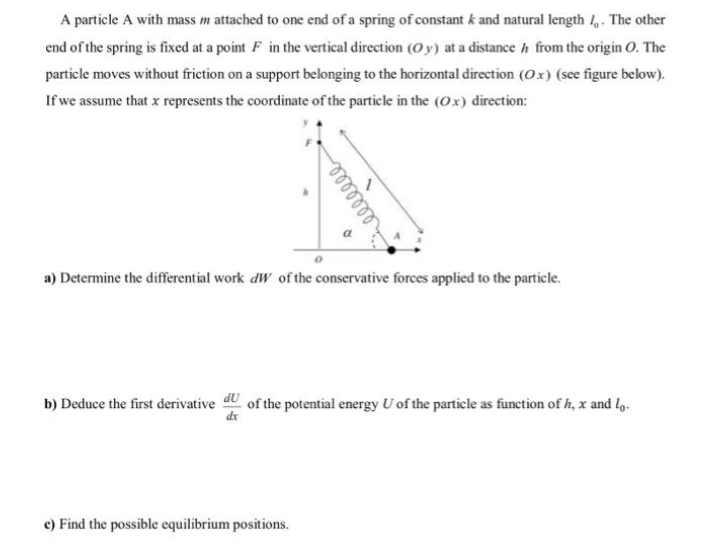A particle A with mass m attached to one end of a spring of constant k and natural length 1,. The other end of the spring is fixed at a point F in the vertical direction (O y) at a distance h from the origin O. The particle moves without friction on a support belonging to the horizontal direction (Ox) (see figure below). If we assume that x represents the coordinate of the particle in the (Ox) direction: a a) Determine the differential work dW of the conservative forces applied to the particle. b) Deduce the first derivative d of the potential energy U of the particle as function of h, x and l,. c) Find the possible equilibrium positions. lellll
A particle A with mass m attached to one end of a spring of constant k and natural length 1,. The other end of the spring is fixed at a point F in the vertical direction (O y) at a distance h from the origin O. The particle moves without friction on a support belonging to the horizontal direction (Ox) (see figure below). If we assume that x represents the coordinate of the particle in the (Ox) direction: a a) Determine the differential work dW of the conservative forces applied to the particle. b) Deduce the first derivative d of the potential energy U of the particle as function of h, x and l,. c) Find the possible equilibrium positions. lellll
Elements Of Electromagnetics
7th Edition
ISBN:9780190698614
Author:Sadiku, Matthew N. O.
Publisher:Sadiku, Matthew N. O.
ChapterMA: Math Assessment
Section: Chapter Questions
Problem 1.1MA
Related questions
Question
5

Transcribed Image Text:A particle A with mass m attached to one end of a spring of constant k and natural length I,. The other
end of the spring is fixed at a point F in the vertical direction (O y) at a distance h from the origin O. The
particle moves without friction on a support belonging to the horizontal direction (Ox) (see figure below).
If we assume that x represents the coordinate of the particle in the (Ox) direction:
a) Determine the differential work dW of the conservative forces applied to the particle.
b) Deduce the first derivative d of the potential energy U of the particle as function of h, x and lg-
c) Find the possible equilibrium positions.
Expert Solution
This question has been solved!
Explore an expertly crafted, step-by-step solution for a thorough understanding of key concepts.
Step by step
Solved in 2 steps with 2 images

Knowledge Booster
Learn more about
Need a deep-dive on the concept behind this application? Look no further. Learn more about this topic, mechanical-engineering and related others by exploring similar questions and additional content below.Recommended textbooks for you

Elements Of Electromagnetics
Mechanical Engineering
ISBN:
9780190698614
Author:
Sadiku, Matthew N. O.
Publisher:
Oxford University Press

Mechanics of Materials (10th Edition)
Mechanical Engineering
ISBN:
9780134319650
Author:
Russell C. Hibbeler
Publisher:
PEARSON

Thermodynamics: An Engineering Approach
Mechanical Engineering
ISBN:
9781259822674
Author:
Yunus A. Cengel Dr., Michael A. Boles
Publisher:
McGraw-Hill Education

Elements Of Electromagnetics
Mechanical Engineering
ISBN:
9780190698614
Author:
Sadiku, Matthew N. O.
Publisher:
Oxford University Press

Mechanics of Materials (10th Edition)
Mechanical Engineering
ISBN:
9780134319650
Author:
Russell C. Hibbeler
Publisher:
PEARSON

Thermodynamics: An Engineering Approach
Mechanical Engineering
ISBN:
9781259822674
Author:
Yunus A. Cengel Dr., Michael A. Boles
Publisher:
McGraw-Hill Education

Control Systems Engineering
Mechanical Engineering
ISBN:
9781118170519
Author:
Norman S. Nise
Publisher:
WILEY

Mechanics of Materials (MindTap Course List)
Mechanical Engineering
ISBN:
9781337093347
Author:
Barry J. Goodno, James M. Gere
Publisher:
Cengage Learning

Engineering Mechanics: Statics
Mechanical Engineering
ISBN:
9781118807330
Author:
James L. Meriam, L. G. Kraige, J. N. Bolton
Publisher:
WILEY